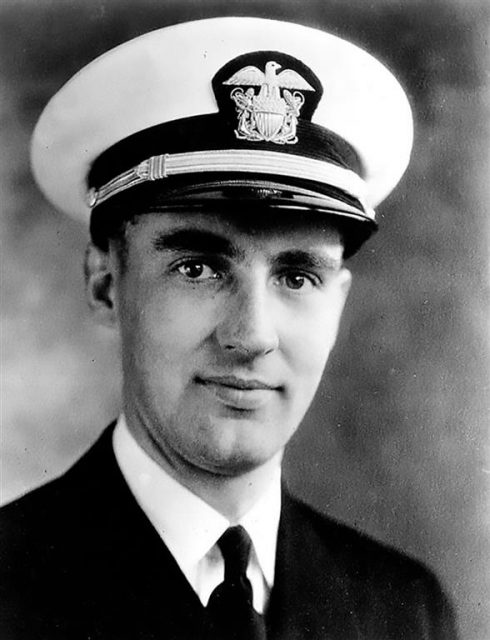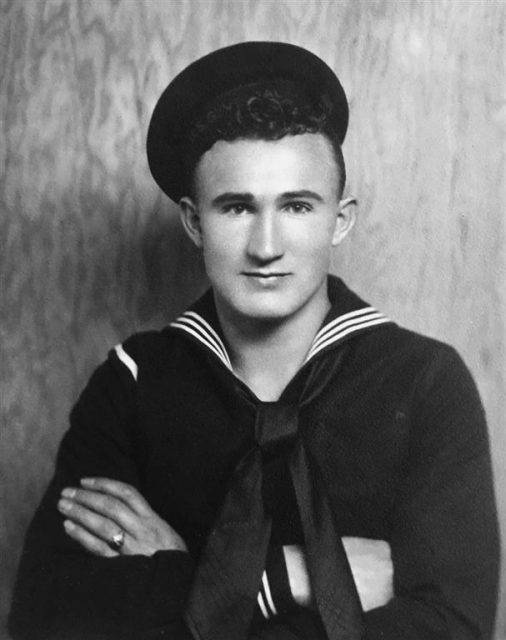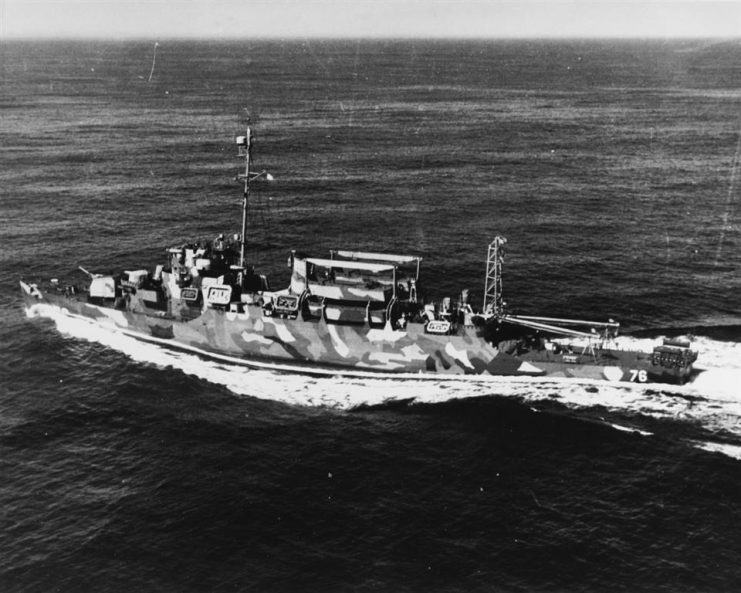The Navy recently authorized the posthumous award of combat medals to two Sailors who were present at Pearl Harbor during the Japanese attack of Dec. 7, 1941, officials announced Monday.
Secretary of the Navy Richard V. Spencer awarded the Silver Star Medal to Chaplain Lt. j.g. Aloysious H. Schmitt for gallantry in action against the enemy while serving on the battleship USS Oklahoma (BB 37). As Oklahoma was capsizing, Schmitt sacrificed his own life to assist many of his shipmates in escaping to safety.
Spencer also awarded the Bronze Star Medal with V device for valor to Chief Boatswain’s Mate Joseph L. George for heroic achievement while serving aboard the repair ship USS Vestal (AR 4). George, a second class petty officer at the time, saved the lives of several Sailors from the battleship USS Arizona (BB 39). He survived the war and retired from the Navy in 1955, but passed away in 1996.
Navy Chief of Chaplains Rear Adm. Margaret Kibben will present the Silver Star Medal to a member of Schmitt’s family during a ceremony on the campus of Loras College in Dubuque, Iowa on Dec. 7. The 8:45 a.m. (Central time) presentation ceremony will be preceded by a special Catholic mass in a campus chapel previously dedicated to Schmitt, and in which his remains are interred.
The Bronze Star Medal will be presented by Rear Adm. Matthew J. Carter deputy commander of the U.S. Pacific Fleet, to George’s daughter, Joe Ann Taylor, on Dec. 7 during a 4:30 p.m. (Hawaii-Aleutian time) ceremony at the USS Arizona Memorial in Pearl Harbor.
“The presentation of the medals is not only appropriate but simply the right thing to do,” said Spencer. “One of my highest priorities is to honor the service and sacrifice of our Sailors, Marines, Civilians, and family members and it is clear that Lt. Schmitt and Chief George are heroes whose service and sacrifice will stand as an example for current and future service members.”

In October 1942 Schmitt was posthumously awarded the Navy and Marine Corps Medal, the Navy’s award for non-combat heroism. The Navy later published a clearer definition of combat for award purposes, making. Schmitt was retroactively eligible for the Silver Star Medal, the military’s third-highest personal decoration for valor in combat. Schmitt’s family petitioned the Navy to upgrade his recognition to a combat valor award.
Similarly, in 1942 George was officially commended by his commanding officer following the attack, but he was not awarded any medal. Lauren Bruner and Don Stratton, two of the USS Arizona Sailors saved by George’s actions, petitioned for him to be presented a medal.
Both families are happy to celebrate the heroism of their loved ones.
In keeping with the tendency of World War II veterans, Taylor says her father never really talked about Pearl Harbor or World War II when she was growing up. But after he retired, he started going to reunions and that is when she began to get the full story.
“It was kind of surreal. You grow up with your dad thinking of him as dad; you’re not used to thinking of him as a hero,” said Taylor. “But it’s a wonderful story and I’m quite proud of him. Plus I’ve gotten to know the men he saved and have developed a real bond with the Stratton and Bruner families.”

Dr. Steve Sloan is the great-nephew of Chaplain Schmitt. Although he never met Schmitt – who was known in the family as “Father Al” – Sloan says the story was a topic of discussion at every family holiday gathering when he was growing up.
“We would talk about what happened, how many Sailors he helped escape, and what went on – we would kind of relive it every holiday and it became a bit of a tradition. So we’re very excited about the medal. I think for the older people in the family it’s a form of closure, but for the rest of us, our hope is that this is just the beginning of the story; that with the return of his remains and the presentation of the medal, his story will become known to a whole new generation.”
According to the Navy’s Nonresident Training Course History of the Chaplain Corps, Part 2, Schmitt was hearing confessions aboard Oklahoma when four torpedoes hit the port side of the ship. As the vessel began to list to port, the crew tried to escape. Schmitt made his way with several others to a compartment in which an open porthole – a small, circular window in the outer hull of the ship – afforded a means of escape. One by one, the Sailors in the space, with Schmitt’s help, crawled through the porthole to safety.
When they were all out, Schmitt attempted to get through the small opening. Even with the frantic assistance offered by the men who were already out, Schmitt struggled to get through the porthole. During the attempt to escape, the chaplain became aware that others had come into the compartment from which he was trying to escape. Realizing that the water was rising rapidly and that even this one exit would soon be closed, Schmitt insisted on being pushed back to help others who could get through more easily, urging them on with a blessing.
As water poured into the ship, she gradually rolled over, and settled on the bottom of the harbor. More than 400 Oklahoma Sailors, including Schmitt, lost their lives.
Named after the chaplain, USS Schmitt (DE 676) was commissioned July 24, 1943. The ship performed convoy escort missions in the Atlantic Ocean before being transferred to the Pacific. The ship also participated in combat operations off Balikpapan, Borneo in the summer of 1945. After conducting peacetime training and upkeep following the end of World War II, the ship was decommissioned on June 28, 1949.

As recounted in an oral history interview conducted by the University of North Texas on Aug. 5, 1978, George said on Dec. 7 he was settling down to read the Sunday newspaper when General Quarters (battle stations) was sounded. That’s when he realized there was an attack underway. To get a better sense of what was going on, he went outside, and the first thing he saw was a Japanese plane going down. With no time to think, his training kicked in and he began to act.
With Japanese torpedoes passing under his ship then striking Arizona, fires were breaking out everywhere. George recalled that the first thing he did, with help from several of his shipmates, was remove the awning covering the guns so that Vestal could fight back. Then he ran across the deck from fire to fire to help put them out.
Meanwhile, Arizona was taking a pounding with explosions and fires encircling the Sailors on her decks.
There were “people over on the Arizona that were trying to get off, and there was fire all around,” George said. “I threw a line over.”
After securing the line as best he could, George returned to fighting fires and controlling damage aboard Vestal. When it became apparent Arizona was doomed, George assisted with getting Vestal underway and away from the burning and fast-sinking battleship. Arizona lost 1,177 crewmembers during the attack. Vestal lost seven.
George went on to serve throughout the war and retired in 1955 as a chief petty officer after twenty years in the Navy.
The Naval History and Heritage Command, located at the Washington Navy Yard, is responsible for the preservation, analysis, and dissemination of U.S. naval history and heritage. It provides the knowledge foundation for the Navy by maintaining historically relevant resources and products that reflect the Navy’s unique and enduring contributions through our nation’s history, and supports the fleet by assisting with and delivering professional research, analysis, and interpretive services. NHHC is composed of many activities including the Navy Department Library, the Navy Operational Archives, the Navy art and artifact collections, underwater archeology, Navy histories, ten museums, USS Constitution repair facility and the historic ship Nautilus.
